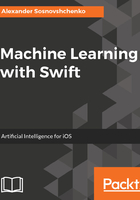
Mathematical optimization – how learning works
The magic behind the learning process is delivered by the branch of mathematics called mathematical optimization. Sometimes it's also somewhat misleading being referred to as mathematical programming; the term coined long before widespread computer programming and is not directly related to it. Optimization is the science of choosing the best option among available alternatives; for example, choosing the best ML model.
Mathematically speaking, ML models are functions. You as an engineer chose the function family depending on your preferences: linear models, trees, neural networks, support vector machines, and so on. Learning is a process of picking from the family the function which serves your goals the best. This notion of the best model is often defined by another function, the loss function. It estimates a goodness of the model according to some criteria; for instance, how good the model fits the data, how complex it is, and so on. You can think of the loss function as a judge at a competition whose role is to assess the models. The objective of the learning is to find such a model that delivers a minimum to the loss function (minimize the loss), so the whole learning process is formalized in mathematical terms as a task of function minimization.
Function minimum can be found in two ways: analytically (calculus) or numerically (iterative methods). In ML , we often go for the numerical optimization because the loss functions get too complex for analytical solutions.
A nice interactive tutorial on numerical optimization can be found here: http://www.benfrederickson.com/numerical-optimization/.
From the programmer's point of view, learning is an iterative process of adjusting model parameters until the optimal solution is found. In practice, after a number of iterations, the algorithm stops improving because it is stuck in a local optimum or has reached the global optimum (see the following diagram). If the algorithm always finds the local or global optimum, we say that it converges. On the other hand, if you see your algorithm oscillating more and more and never approaching a useful result, it diverges:
